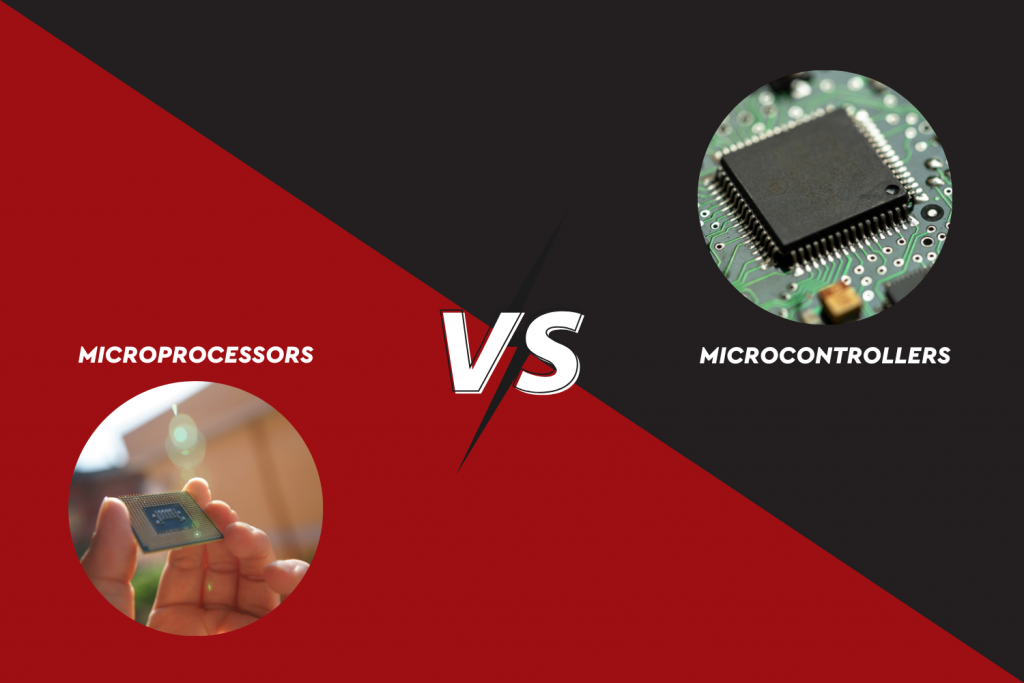
Microcontrollers vs. Microprocessors : A Cake Analogy
Just like baking a cake requires both an oven and ingredients, a computer needs both a microprocessor and microcontrollers to function properly. The microprocessor handles overall control, while the microcontrollers manage individual components.
Contents
Introduction
Imagine you’re baking a cake. You need different tools to mix the ingredients and control the oven’s temperature. In electronics, a microprocessor and a microcontroller are like these tools, each serving a specific purpose.
Let’s Bake a Cake
Picture yourself in a kitchen, baking a cake. The kitchen appliances represent electronic components in a computing system.
Microprocessor: The Head Chef
Think of a microprocessor as the head chef in a bakery. The head chef’s main job is to develop recipes, decide on ingredients, and plan the baking process. Once the plan is ready, the chef assigns tasks to various kitchen appliances like mixers, ovens, and timers, which then follow the chef’s instructions to bake the cakes. In this analogy, the microprocessor is like the head chef, executing instructions and performing calculations, but it needs external components (like memory and input/output devices) to function effectively.
Microcontroller: The Automated Cake Maker
Now, consider a microcontroller as an automated cake-making machine. Imagine a compact machine programmed to mix ingredients, set the temperature, control the baking time, and even decorate the cake. You input the instructions into the machine’s control panel, and it handles the entire process without external help. In this analogy, the microcontroller is like the automated cake maker, integrating the core processing unit, memory, input/output peripherals, and other components all in one package. It’s designed to execute specific tasks autonomously, like controlling a microwave oven, washing machine, or simple robot.
Microprocessor: The Brain
A microprocessor is like the brain of a computer or device, processing information and performing calculations, much like your brain helps you think and make decisions. Whether solving a math problem on your computer or playing a video game on your console, the microprocessor ensures everything runs smoothly with its powerful processing capabilities.
Key Attributes of Microprocessors:
- Processing Power: Built for raw processing power, suitable for tasks requiring intensive computation.
- Versatility: Capable of running a wide range of applications, from operating systems to complex software programs.
- Arithmetic and Logic Operations: Performs arithmetic and logical operations, enabling various calculations and decision-making processes.
- External Components: Often requires external components for input/output operations and communication.
 Microcontroller: The Body
Microcontroller: The Body
Now, think of a microcontroller as the “controller” of a device. It’s like the mini-computer inside gadgets and machines, helping them perform specific tasks. Imagine a remote-controlled car; the microcontroller inside it makes the car move forward, backward, or turn according to signals from the remote. It’s like the car’s brain, following instructions to perform actions. Microcontrollers are not as powerful as microprocessors but excel at managing one task very well.
Key Attributes of Microcontrollers:
- Specific Functions: Tailored for specific tasks within devices, focusing on control and response to inputs.
- Built-in I/O Ports: Equipped with input/output (I/O) ports, allowing direct interfacing with sensors, switches, and external devices.
- Low-Power Consumption: Optimized for low-power consumption, making them suitable for devices needing to operate for extended periods.
- Task-Oriented: Executes pre-programmed instructions to perform tasks like reading sensor data, making decisions, and controlling outputs.
Comparison
To sum it up:
- Microprocessor: Like a super-smart person who can do many different things quickly. It’s great for running big programs and handling complex tasks, like your computer’s brain.
- Microcontroller: Imagine a dedicated worker excelling at one specific job. It’s not as powerful as the smart person, but it’s excellent at controlling devices and making them work smoothly.
In short, a microprocessor is like a general-purpose brain handling various tasks, while a microcontroller is a specialized brain managing specific actions in devices. Both are essential in electronics, making our gadgets and machines function as they do.

Conclusion: Embracing the Roles of Microprocessors and Microcontrollers
Microprocessors and microcontrollers are the unsung heroes driving technological advancements. Microprocessors serve as the computational powerhouses behind our computing devices, while microcontrollers empower devices to be smart, responsive, and efficient. Recognizing the distinctions between these components allows us to appreciate their contributions to our daily lives, from the devices we use to the convenience they bring. As technology evolves, the significance of microprocessors and microcontrollers remains steadfast, guiding us towards a future enriched with automation, connectivity, and efficiency.
(Source: techovedas)
 Microcontroller: The Body
Microcontroller: The Body